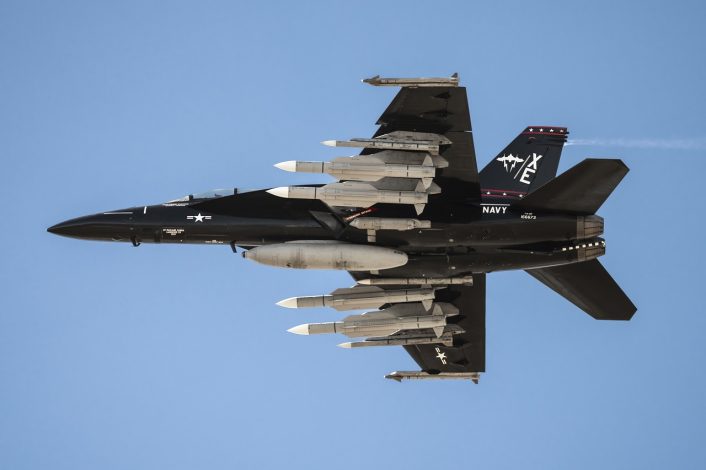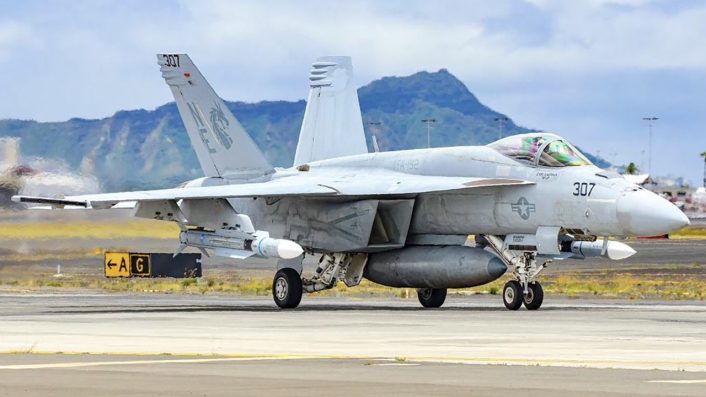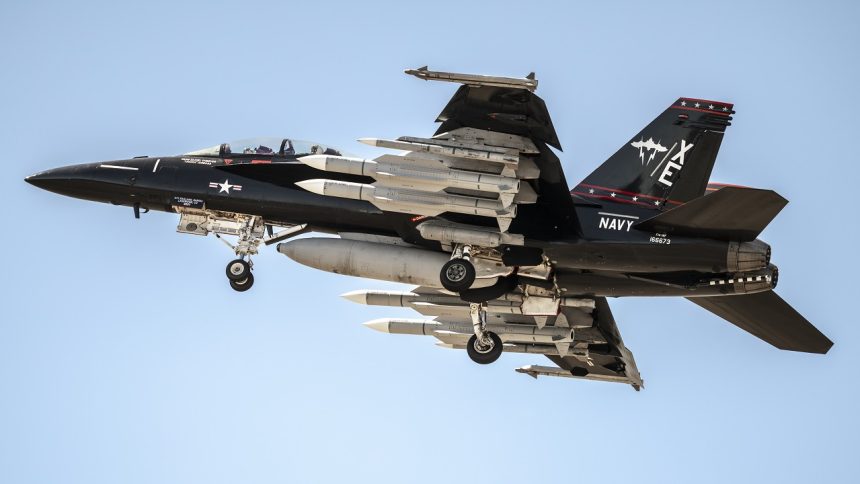The U.S. Navy is continuing to test the new AIM-174B missile, derived from the SM-6, aboard the Super Hornet, with a VX-9 jet carrying four AIM-174s, three AIM-120s and two AIM-9Xs.
A U.S. Navy F/A-18F Super Hornet of VX-9 “Vampires” was spotted with a heavy air-to-air loadout, which includes four AIM-174Bs, three AIM-120s and two AIM-9Xs, in addition to a targeting pod and an InfraRed Search and Track installed on the external fuel tank. Aviation photographer @point_mugu_skies was one of the few to capture the aircraft in this previously unseen configuration and kindly provided us the images you can see in this article.
The aircraft is the Vampires’ flagship, “Vandy 1”, which sports the black livery applied for the unit’s 30th anniversary to pay tribute to the original one which was used on VX-4 commander’s F-4s and F-14s, also known as “Vandy 1”. The callsign originated from the abbreviation of the unit’s official callsign “Vanderbilt” used at the time.
As The Aviationist has reported in detail in the last few months, the AIM-174B is a Standard Missile (SM) 6 variant developed for the air-to-air role. The SM-6 is the surface-to-air missile designed to be used on Navy ships in conjunction with the Aegis Combat System and also known as the RIM-174 Standard Extended Range Active Missile (ERAM).
YOOOOOO pic.twitter.com/OHwSh4uBev
— John Ridge 🇺🇸 🇺🇦 (@John_A_Ridge) September 11, 2024
The idea of adapting the SM-6 to be air-launched is not new, as the weapon was already seen on a Super Hornet of VX-31 in 2018 and 2021. However, it wasn’t until earlier this year that the testing got a new impulse and operational units were involved.
In fact, after another F/A-18 was spotted in April with an SM-6 under the wing, the weapon then appeared on operational jets assigned to the USS Carl Vinson aircraft carrier during the Rim of The Pacific 2024 (RIMPAC 2024) exercise in July. The heaviest load seen so far included two AIM-174s and two AIM-120s.
The one seen in the latest photo is reportedly the heaviest air-to-air load to date with the new weapon, with the AIM-174 both on the inner and middle wing hardpoints. It’s interesting to note also the presence on the external fuel tank of the ASG-34A IRST, which acts as a complementary sensor to the AN/APG-79 fire control radar in a heavy electronic attack or radar-denied environment.

AIM-174B
As previously explained, the AIM-174 is an air-launched version of the RIM-174 Standard Extended Range Active Missile (ERAM), a crucial element of the US Navy’s air defense strategy. Integrated into the Aegis Combat System, the RIM-174 is primarily designed for long-range anti-air warfare but can also be employed for terminal phase ballistic missile defense and as an anti-ship missile. This year marked the first official combat use of the SM-6, with the Department of Defense confirming that the USS Carney intercepted and destroyed an anti-ship ballistic missile fired by Houthi rebels in the Gulf of Aden on January 30, 2024.
The SM-6 uses the airframe of the SM-2ER Block IV (RIM-156A) missile, upgraded with an active radar homing seeker derived from the AIM-120 AMRAAM air-to-air missile. This missile can reach speeds of up to Mach 3.5 and has a maximum range of 200 nautical miles. To that respect, it’s not clear what the maximum range of the air-launched version could be: despite the lack of a booster, launching it at high speed and altitude would result in significantly greater range compared to the surface-launched variant.
With the induction of the AIM-174B into service, the U.S. Navy joins a number of air arms capable of deploying an extra-long-range beyond-visual-range air-to-air missile (BVRAAM), like the MBDA Meteor, the Russian R-37M and Chinese PL-15 and PL-21. In fact, the AIM-174B enables the U.S. Navy Super Hornets to engage targets at much greater distances than is currently possible with the AIM-120 AMRAAM. Integrated with the E-2D, F-35, and AEGIS within the Naval Integrated Fire Control-Counter Air (NIFC-CA) system, the AIM-174B would extend the Navy’s capability to intercept aerial targets at ranges comparable to (if not greater than) those achieved against naval targets using the baseline SM-6.
In essence, this new missile fills the gap left by the retirement of the AIM-54 Phoenix. The AIM-54 was a long-range air-to-air missile used by the U.S. Navy’s F-14 Tomcat and retired in 2004 alongside the F-14. Known for its impressive range of over 100 nautical miles and multiple-target engagement capability, the AIM-54 left a significant void in long-range engagement capabilities.
While there wasn’t a direct replacement for the AIM-54 Phoenix in terms of range, the U.S. military has been developing advanced air-to-air missiles to enhance its fighter aircraft capabilities. The AIM-260 Joint Advanced Tactical Missile (JATM) is one such development intended to replace the AIM-120 AMRAAM. Although not a direct replacement for the AIM-54 Phoenix, the AIM-260 aims to offer improved range and performance compared to the AIM-120.

Operationally deployed
The photo of the new weapon during a test flight in April 2024 was reportedly part of the testing that preceded the delivery of the AIM-174B to the squadron likely to carry out Operational Test and Evaluation (OT&E), a testing phase conducted on production, or production representative weapons, to determine whether systems are operationally effective and suitable to support a Full-Rate Production (FRP) decision.
In July, the U.S. Navy acknowledged that the AIM-174 is operationally deployed, likely in Initial Operating Capability (IOC) with the CVW-2 Air Wing’s Super Hornet squadrons aboard the USS Carl Vinson (CVN-70), as reported by Naval News. “The SM-6 Air Launched Configuration (ALC) was developed as part of the SM-6 family of missiles and is operationally deployed in the Navy today,” said a U.S. Navy spokesperson.
While the service acknowledged the existence and the deployment of the weapon, so far only the NAIM-174B inert, CATM-174B captive carry, and DATM-174B ground training variants were seen installed on aircraft. However, the fact that the Navy mentioned the weapon being operationally deployed implies that live variants might also been delivered.
The Navy did not disclose other details about the AIM-174. So far, we know the standard SM-6 missile is about 21 feet (6.4 meters) long and, using persons for scale in some of the few photos available, the AIM-174B seems to be of similar length. According to the stencils visible on the photos of the missile carried by the CVW-2 Super Hornets taking part in RIMPAC, the weapon weighs 1,890 lb ± 14 lb (857 kg ± 6 kg).
Thanks again to @point_mugu_skies for the photos he sent us and make sure to follow him on Instagram for more!









